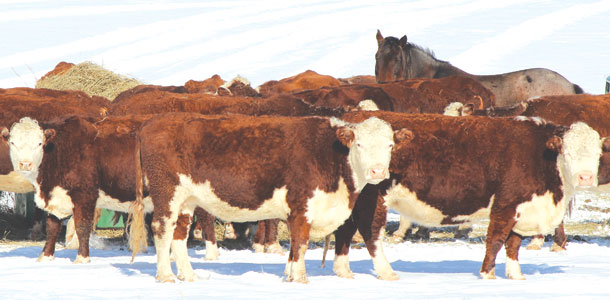But how do we create the correct balance of feed costs and overall herd performance? A starting point may be to evaluate your winter cow ration.
The winter ration for the cow herd is vitally important because not only is the cow maintaining her condition during times of extreme temperatures, she is also supporting a growing fetus.
Historically, the first and second trimesters of gestation have been looked at as a period of “cruise control” as far as the level of nutrients provided goes; however, there are benefits to sustaining a more consistent plane of nutrition for the gestating cow and her developing fetus through the winter.
Research from the University of Nebraska shows that providing cows with a ration that maintains a body condition score (BCS) of 5.5 to 6 on a nine-point scale through all seasons is beneficial.
In a recent study, researchers looked at herds over a three-year timespan, beginning with two groups of cows: one group with adequate BCS in the final third of gestation and one group with BCS levels that continued to decrease through the winter.

On average, cows with maintained BCS through winter produced heavier birthweight calves (81 pounds versus 79 pounds), weaned heavier calves (476 pounds versus 462 pounds) and the calves’ carcass weights were greater (812 pounds versus 799 pounds).
A similar study followed the lifetime of heifers produced from cows of two separate BCS levels in gestation.
In addition to improved growth rates pre-weaning, heifers born from cows with adequate BCS in gestation saw improvements in conception rate (93 percent versus 80 percent).
To aim for these improvements in calf performance and cow reproduction, producers must evaluate their rations.
A winter ration of only forage may be the most inexpensive option in the short run, but long-term performance may be impacted, resulting in decreased efficiency overall.
Forages
Across the country, winter cow rations are typically maintenance-focused, with stored forages comprising the majority of the herd’s diet.
Free-choice forages allow the herd the option to consume forage as needed, a necessary tool with fluctuating temperatures.
Additional forage nutrients are necessary as temperatures decrease, according to researchers at North Dakota State University, who have found that cows consume more than predicted as temperatures decrease.
This research shows that cattle consume 105 to 110 percent of predicted intake when temperatures fall below 22ºF, and intake climbs to 125 percent of predicted intake when temperatures are below 5ºF. In contrast, intake may be reduced when wind chills are below -20ºF because cattle opt to stay in sheltered areas.
To accommodate for added nutrients required during cold spells, producers are encouraged to increase total digestible nutrients (TDN) by 1 pound for every five degrees below 0ºF.
Forage testing of stored forages is vital in determining the TDN levels provided and then adding supplementation to help meet the herd’s needs.
Minerals
Free-choice forages balanced on nutrients provide the bulk of the winter cow ration, but they may not always provide the quality nutrients needed to support the cow’s maintenance and the fetal development.
The balance of performance and feed costs that results in efficient production can be improved through a well-balanced mineral program.
A properly formulated mineral program can improve a cow’s metabolic function, helping to maintain adequate BCS levels.
Supplementing forage with a mineral program directly impacts the bacteria in the rumen, helping the cow to secure more energy from the fed forage.
The aforementioned studies on fetal development and long-term calf performance are a testament to the power of supplementation because the only difference in the rations between the two groups was the addition of mineral and protein supplements.
The lack of supplementation in the cow herds was one of the main factors in the decreased BCS levels.
Molasses
Utilizing molasses-based supplements can help keep cows consuming the nutrients they require prior to calving.
A recent research study conducted by Purina Animal Nutrition and Kansas State University found that supplements with molasses resulted in optimal performance, with 1 pound of cooked molasses product increasing overall digestibility and the energy the cows received from the forage.
With this added digestibility, it is possible to maintain BCS levels through gestation without the addition of supplemental forage, such as hay cubes or other pricey forages, without sacrificing future calf performance.
Pre-calving surge
Keeping cows in adequate BCS through the winter helps best set them up for calving. An additional way to promote early lactation success is to adjust the ration 60 days prior to calving to adjust for the growing fetus.
A recommended ration adjustment is to use the highest-quality forages which will increase diet energy the last 60 days pre-calving.
The additional energy helps provide nutrients the fetus needs through increased digestibility as the capacity of the cow’s rumen decreases.
Through the entire gestation period, it is a combination of adequate forage levels, supplementation and herd management that promotes consistent body condition levels.
By selecting the correct supplementation option for the cow herd and supplementing forage year-round, cows are better able to maintain a consistent BCS through all seasons – a winning combination for an efficient cow-calf operation. ![]()
For more information on cattle feeding and mineral supplementation click here, or contact Ted Perry or call (816) 243-6231.
References omitted due to space but are available upon request. Click here to email an editor.









